Press here for your head
There’s nothing like a throbbing head to wreck your day. But instead of reflexively reaching for a pill, you could actually help your body heal itself: In traditional Chinese medicine, acupuncture and acupressure have been used for pain management for thousands of years, and it looks like Western science may finally be catching on to this approach. “Science is showing more and more that the stimulation of certain pressure points can affect the neural fibers in the brain as well as the peripheral nervous system,” says Paul Robison, a licensed acupuncturist in Washington, D.C., and the founder of Flourish Health Arts. A review of studies published in 2016 in the Cochrane Database of Systematic Reviews, for instance, found that acupuncture was effective in helping treat patients with frequent or chronic tension-type headaches. And a study published in 2017 in JAMA Internal Medicine found that acupuncture not only helps get rid of a migraine, it can also reduce the frequency that people have them.
Acupuncture involves inserting needles along specific pathways, called meridians, which may stimulate the body’s healing process. Acupressure stimulates the same pressure points but relies on fingers instead of needles to apply pressure. “It’s all about releasing tension and restoring balance in the body,” Robison says.
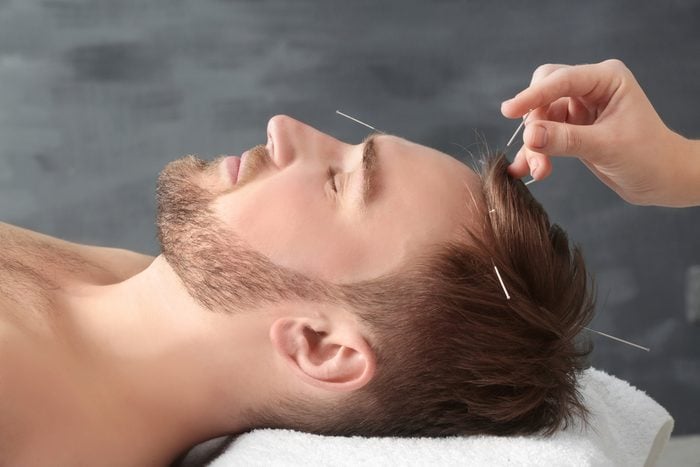
Using pressure points for headaches vs. acupuncture
With acupuncture, trained professionals use superfine needles to target key points. While acupressure may not be as precise, it may help, says Robison. Either way, you can get better results with the guidance of a professional; a pro can also help you develop a personalized protocol you can follow at home. For those seeking relief right now, Robison provides the following guide to pressure points for different types of headache pain.
(Find out if facial reflexology can cure your ailments.)
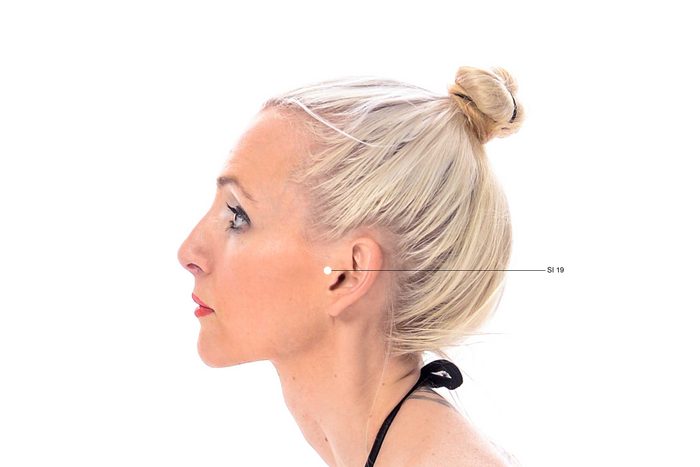
Pressure point to relieve tension headaches and jaw pain
The pressure point known as SI-19 (short, for point 19 of the Small Intestine meridian) is located in each ear. Targeting this sweet spot not only alleviates tension headaches and jaw pain, it can also help treat tinnitus and toothache.
- Starting at the tragus of your left ear, that small bit of cartilage in the center of the outer ear, move your index finger toward your nose about an inch.
- Open and close your mouth and you should feel a slight depression. Place your index, middle, and ring fingers on that spot and massage in small, counterclockwise circles for about 30 seconds.
- Slowly move your fingers down the jawline.
- Repeat on your right ear.
(Want to learn the difference between a migraine and a headache?)
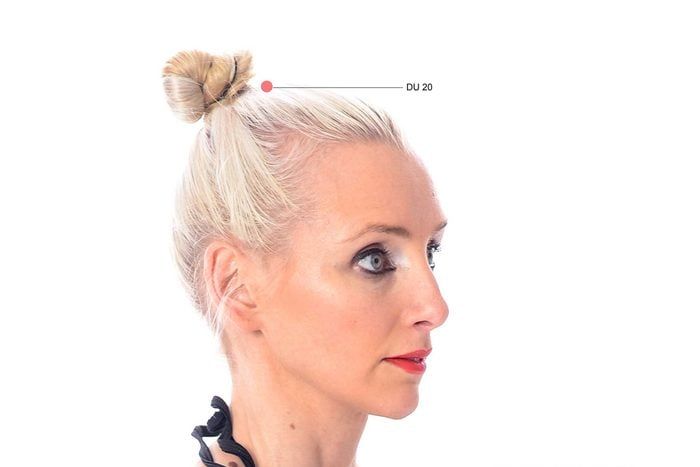
Pressure point to relieve tension-type headache
Top-of-head pain, often caused by stress and tension, is the most common type of headache. Targeting the pressure point DU-20 (known as “Hundred Meetings” in Chinese, it also translates to “convergence”) can help alleviate the sort of dull pain that’s typically associated with tightness of the scalp.
- Press the middle fingers of both hands onto the highest point at the top of your head.
- Making very small circles, slowly move down either side of your skull toward your ears.
- Repeat as needed.
(Find out more about these 8 types of headaches—and how to get rid of them.)
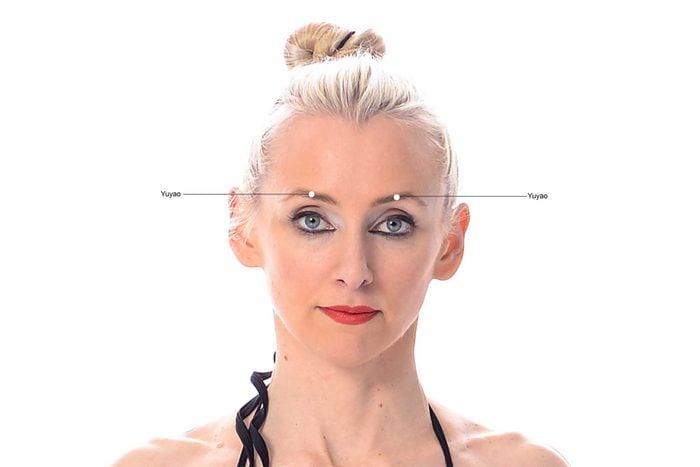
Pressure points to relieve eyestrain headaches
These types of headaches are very rare, which is surprising given that they’re directly related to eyestrain. Two pressure points are targeted to alleviate the pain, which is usually concentrated on both sides of the forehead: Yuyao, at the midpoint of the eyebrow in a depression directly above the pupil; and UB-2, located at the middle of the eyebrow, directly above the inner corner of the eye.
- Using the tips of your index fingers, press at the midpoint of your eyebrows for one minute, then release.
- Using the tips of your index fingers, press into the small depression at the inner corners of your eyebrows.
- Apply steady pressure in small circles for one minute, then release. Repeat three to five times.
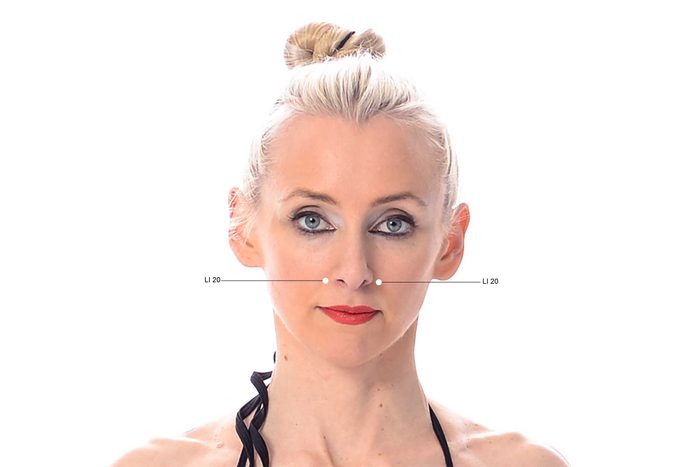
Pressure points to relieve sinus headaches
The pain over the nasal area that’s caused by a sinus headache is often caused by acute infection, which can block sinus ducts and prevent normal drainage. In that case, you’ll need antibiotics or a decongestant to get rid of the infection. In the meantime, targeting two pressure points can help alleviate the pain: LI-20 (short, for Large Intestine 20), located next to the nostrils; and DU-24 (which translates to Spirit Courtyard), found just above the midpoint of your hairline.
- Press on either side of the bridge of your nose with your thumb and index finger.
- Hold for one to two minutes. Repeat three times.
- Using your two index fingers, press the DU-24 pressure point.
- Making very small circles, slowly move down either side of your skull toward your ears.
(Check out these 11 ways to stop a headache before it starts.)
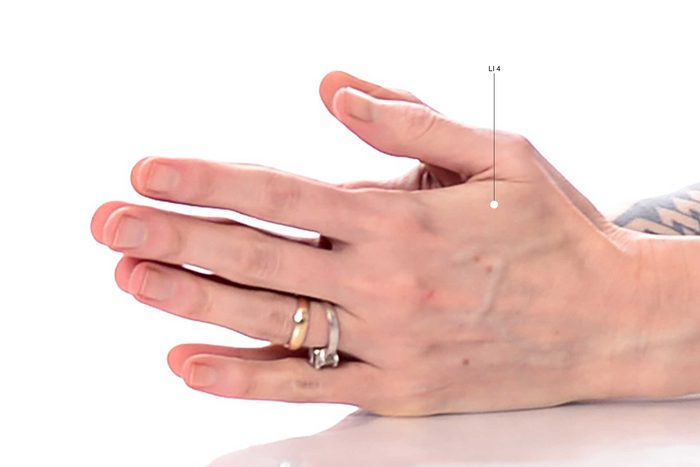
Pressure point to relieve general headaches
Not all pressure points for headache pain are located on your head. What’s known as pressure point LI-4 (also called Hegu) can be found between the base of your thumb and index finger. Doing acupressure on this point can relieve pain and headaches. That’s because “meridians are pathways of circulation in the body,” says Robison. You can treat pain by accessing either end of those paths.
- Make an L shape with your left hand.
- Using your right thumb and index finger, press down on the spot where the two legs of the L meet.
- Move your thumb in a circular motion while applying pressure for five minutes. Be firm, but don’t press so hard that it hurts.
- Repeat on your right hand.Expectant mothers, take note: You may want to skip this move, as it may induce labor.
(Woke up with a headache? Here’s what to do next.)
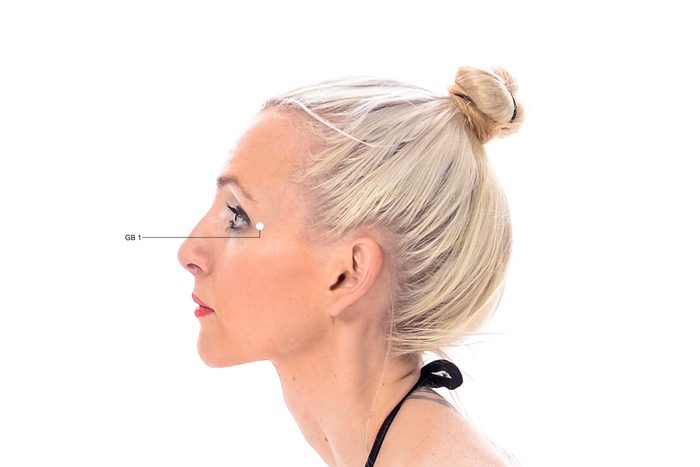
Pressure point to relieve temple headaches
People intuitively target their temples—or pressure point GB-1 along the gallbladder meridian—when they’re stressed, says Robison.
- Place your forefingers in the soft depression on either side of your head, behind your eyes between your forehead and ears.
- Rub gently, using a firm, circular motion for 30 seconds, then gradually release the pressure. Robison suggests using an up and forward motion if your ache is due to sleep deprivation or screen time, and a back and down motion if it’s caused by physical strain.
Next: Check out 13 surprising things that could be triggering your headaches.
